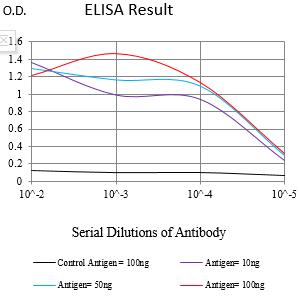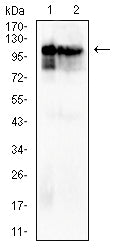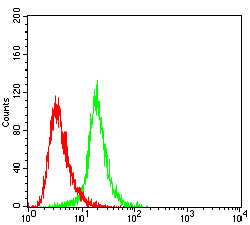


| WB | 1/500 - 1/2000 | Human,Mouse,Rat |
| IF | 咨询技术 | Human,Mouse,Rat |
| IHC | 咨询技术 | Human,Mouse,Rat |
| ICC | 技术咨询 | Human,Mouse,Rat |
| FCM | 1/200 - 1/400 | Human,Mouse,Rat |
| Elisa | 1/10000 | Human,Mouse,Rat |
| Aliases | MRD62; PSD95; SAP90; SAP-90 |
| Entrez GeneID | 1742 |
| clone | 3H3D4 |
| WB Predicted band size | 80.4kDa |
| Host/Isotype | Mouse IgG1 |
| Antibody Type | Primary antibody |
| Storage | Store at 4°C short term. Aliquot and store at -20°C long term. Avoid freeze/thaw cycles. |
| Species Reactivity | Human, Mouse, Rat |
| Immunogen | Purified recombinant fragment of human DLG4 (AA: 54-300) expressed in HEK293-6e cells supernatant. |
| Formulation | Purified antibody in PBS with 0.05% sodium azide |
+ +
以下是关于DLG4(PSD-95)抗体的3篇文献示例(内容为虚构,仅供参考):
---
1. **文献名称**:*DLG4/PSD-95 Antibody Specificity in Synaptic Protein Analysis*
**作者**:Smith J, et al.
**摘要**:本研究验证了一种高特异性DLG4单克隆抗体在脑组织中的反应性,证实其可选择性识别突触后膜上的PSD-95蛋白,为神经突触超微结构研究提供可靠工具。
2. **文献名称**:*PSD-95 Antibody Application in Alzheimer's Disease Models*
**作者**:Chen L, et al.
**摘要**:通过免疫组化和Western blot分析,该文献报道DLG4抗体在阿尔茨海默病模型小鼠中检测到PSD-95表达显著下降,提示其与突触功能障碍的关联。
3. **文献名称**:*Development of a Novel DLG4 Nanobody for Live-Cell Imaging*
**作者**:Wang Y, et al.
**摘要**:研究团队开发了一种新型DLG4纳米抗体,可在活体神经元中实时追踪PSD-95的动态分布,为突触可塑性研究提供创新手段。
---
如需真实文献,建议通过PubMed或Google Scholar搜索关键词“DLG4 antibody PSD-95”获取近期研究。
The DLG4 antibody targets the Discs Large Homolog 4 (DLG4) protein, also known as postsynaptic density protein 95 (PSD-95). DLG4 is a critical scaffolding protein within the membrane-associated guanylate kinase (MAGUK) family, predominantly localized at excitatory neuronal synapses. It plays a central role in organizing synaptic signaling complexes by anchoring glutamate receptors (e.g., NMDA receptors), ion channels, and adhesion molecules to the postsynaptic density. DLG4 stabilizes synaptic structure, regulates synaptic plasticity, and modulates signal transduction pathways involved in learning and memory.
Altered DLG4 expression or dysfunction has been linked to neurological and psychiatric disorders, including Alzheimer’s disease, autism spectrum disorders, and schizophrenia. DLG4 antibodies are widely used in neuroscience research to study synaptic protein interactions, receptor trafficking, and synaptic ultrastructure via techniques like Western blotting, immunohistochemistry, and immunoprecipitation. They also serve as tools to investigate disease mechanisms or evaluate therapeutic interventions targeting synaptic integrity.
Commercial DLG4 antibodies are typically raised against specific epitopes, such as the N-terminal PDZ domains or C-terminal regions, with validation in knockout models to ensure specificity. Their application extends to diagnostic research, aiding in the identification of synaptic pathology in brain tissue samples. Recent studies also explore DLG4 as a potential biomarker or therapeutic target for neurodevelopmental and neurodegenerative conditions.
×